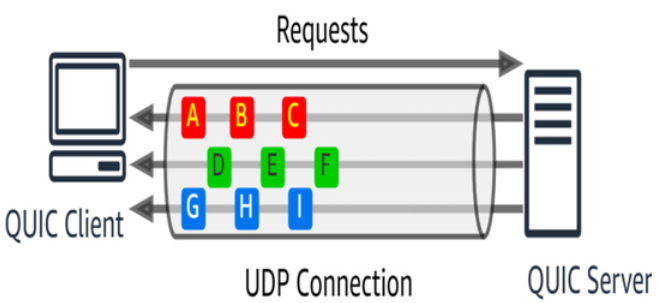Multiplexing and stream management – Understanding Network and Security for Near-Edge Computing
HTTP/2 introduced multiplexing, allowing multiple streams to be sent concurrently over a single connection. However, managing streams and their dependencies can become complex, leading to suboptimal performance. QUIC improves upon this by providing more efficient multiplexing and stream management. It allows for independent flow control and enables better prioritization of streams, ensuring optimal utilization of available network resources:

Figure 2.12 – Comparison of HTTP/1.1 and HTTP/2 with QUIC
By addressing these issues, HTTP/3 and QUIC aim to enhance the performance, security, and reliability of web applications. The protocol’s ability to reduce latency, mitigate the impact of packet loss, provide built-in encryption, and offer efficient network traversal makes it well-suited for modern web communications, especially in scenarios with unreliable or congested networks. The widespread adoption of HTTP/3 and QUIC is expected to contribute to faster, more secure, and more efficient communications on the internet.
Downsides of HTTP/3 and QUIC
While HTTP/3 and QUIC offer numerous benefits for web communication, there are also some drawbacks and challenges associated with their increased use on the internet. Let’s look at a few considerations.
Limited adoption
HTTP/3 and QUIC are relatively new protocols, and their adoption is still in progress. As a result, not all web servers, clients, and network infrastructure fully support these protocols. This limited compatibility may pose challenges when you’re trying to establish connections with systems that do not support HTTP/3 or QUIC yet. So, when implementing HTTP/3, it is important to include mechanisms that redirect incompatible clients to HTTP/1.1 or HTTP/2 versions of the service in question.
Migration complexity
Migrating from older protocols, such as HTTP/1.1 or HTTP/2, to HTTP/3 and QUIC can be complex and time-consuming. It requires updating server software, client libraries, and network infrastructure. This migration process may involve compatibility issues and necessitate careful planning and testing to ensure a smooth transition.
Increased resource consumption
While HTTP/3 and QUIC are designed to improve performance, they may also lead to increased resource consumption compared to older protocols. The additional encryption and packet-level parallelism introduce some overhead, requiring more processing power and bandwidth. This could impact the performance of resource-constrained devices or networks with limited resources.
Network congestion
The use of UDP as the underlying transport protocol for QUIC can potentially lead to network congestion issues. UDP packets bypass congestion control mechanisms used by TCP, leading to increased congestion in networks that aren’t prepared. However, QUIC includes its own congestion control mechanisms, which attempt to mitigate this concern. Monitoring and fine-tuning these mechanisms is crucial to maintaining a fair and efficient network.
You may also like
Archives
- August 2024
- July 2024
- June 2024
- May 2024
- April 2024
- March 2024
- February 2024
- January 2024
- December 2023
- November 2023
- October 2023
- September 2023
- August 2023
- July 2023
- May 2023
- April 2023
- February 2023
- January 2023
- November 2022
- October 2022
- September 2022
- August 2022
- July 2022
- June 2022
- May 2022
- April 2022
- December 2021
- November 2021
- October 2021
- September 2021
- June 2021
Calendar
| M | T | W | T | F | S | S |
|---|---|---|---|---|---|---|
| 1 | 2 | 3 | 4 | 5 | 6 | |
| 7 | 8 | 9 | 10 | 11 | 12 | 13 |
| 14 | 15 | 16 | 17 | 18 | 19 | 20 |
| 21 | 22 | 23 | 24 | 25 | 26 | 27 |
| 28 | 29 | 30 | ||||
Leave a Reply